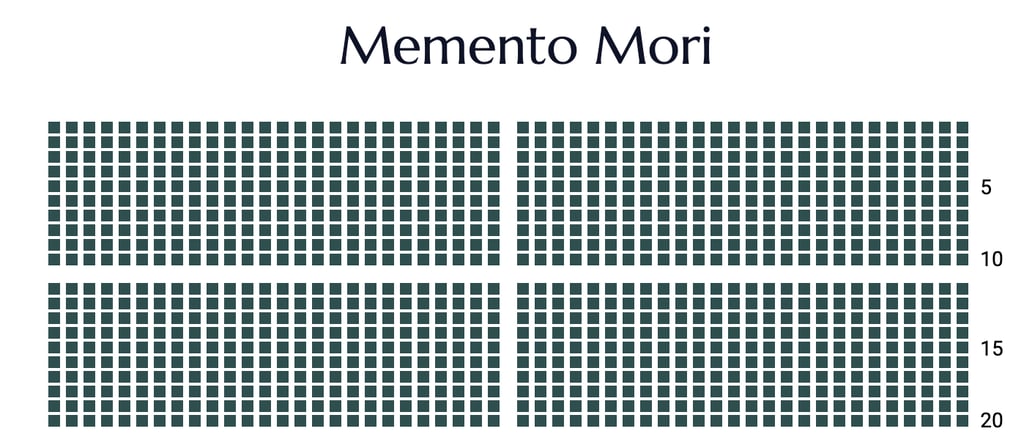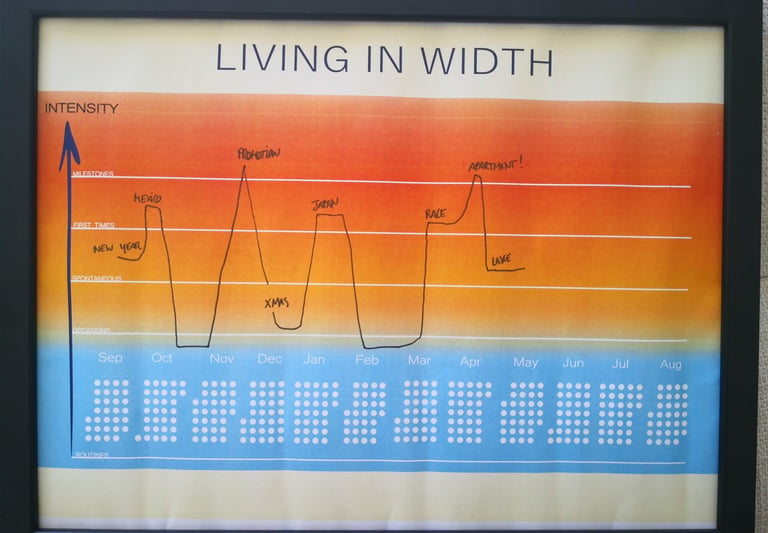How to incorporate Memento Mori into daily life: a stoic approach to living fully with the Wide Time calendar
Discover how to incorporate memento mori into daily life with Stoic practices and the Wide Time Calendar. Learn to reflect, plan, and live each moment with intention and purpose


Understanding Memento Mori
In our fast-paced modern world, it’s easy to get lost in tasks, notifications, and deadlines. Yet, the ancient Stoics remind us of a timeless truth: life is fleeting. The practice of memento mori, or “remember you must die,” isn’t meant to be morbid—it’s a tool to help us live with intention, clarity, and focus.
This concept encourages individuals to reflect on mortality, ultimately guiding them toward a more meaningful existence. By recognizing the impermanence of time, we can shift our focus to living fully in the present and appreciating the moments that shape our journey.
Marcus Aurelius also reminds us, “You could leave life right now. Let that determine what you do and say and think.” This Stoic wisdom encourages us to confront mortality—not with fear, but with clarity and purpose.
As Seneca wrote, “It is not that we have a short time to live, but that we waste much of it.” This insight has guided countless individuals toward reflection and mindfulness. But the question remains: how can we bring memento mori into daily life without feeling overwhelmed?
Stoicism in Practice: Reflection vs. Action
I grew up in Italy, immersed in the wisdom of Seneca and other Stoic thinkers. Translating their Latin texts as a teenager, the concept of memento mori became more than an idea—it became a lens through which I viewed life. To cultivate this awareness daily, I used a Stoic calendar in my bedroom. Its benefits were clear:
It provided perspective, reminding me that life is finite and precious.
It encouraged presence, helping me appreciate the moment instead of rushing through it.
It supported reflection, prompting me to zoom out, check in with myself, and focus on what truly mattered.
Yet over time, I noticed a limitation. While reflection was enlightening, it didn’t always lead to action. I could see patterns in my days but struggled to translate insight into meaningful change.
Stoicism in Practice: Reflection vs. Action


It is not that we have a short time to live, but that we waste much of it - Seneca
I grew up in Italy, immersed in the wisdom of Seneca and other Stoic thinkers. Translating their Latin texts as a teenager, the concept of memento mori became more than an idea—it became a lens through which I viewed life. To cultivate this awareness daily, I used a Stoic calendar in my bedroom. Its benefits were clear:
It provided perspective, reminding me that life is finite and precious.
It encouraged presence, helping me appreciate the moment instead of rushing through it.
It supported reflection, prompting me to zoom out, check in with myself, and focus on what truly mattered.
Yet over time, I noticed a limitation. While reflection was enlightening, it didn’t always lead to action. I could see patterns in my days but struggled to translate insight into meaningful change.
The Wide Time Calendar: Bridging Reflection with Action


Begin at once to live, and count each separate day as a separate life - Seneca
I could track days, jot down thoughts, and reflect on mortality—but it was hard to see progress or patterns. I was looking back, but not learning enough from what I observed.
This realization led me to create the Wide Time Calendar. It’s designed differently from a standard Stoic calendar:
Like the Stoic calendar, it encourages zooming out from daily tasks.
But instead of merely showing how time passes, it visualizes patterns in how you live—the intensity, experiences, and richness of your days.
Rather than seeing time as a flat sequence of weeks and months, it allows you to perceive the depth or width of your time—how full it feels, not just how long it lasts.
Bridge Stoic reflection with practical action, transforming awareness into results.
For me, the Wide Time Calendar became a bridge between Stoic reflection and practical action. It transforms insight into awareness you can act on, helping you live intentionally while honoring the principles of memento mori.
As Seneca reminds us, “Begin at once to live, and count each separate day as a separate life.” By using a calendar that visualizes the depth and richness of your time, you can make that Stoic wisdom actionable.
The Wide Time Calendar serves as a robust tool for managing time effectively while embracing the principles of memento mori. Unlike traditional calendars, it visualizes life not just in linear days or weeks, but as a series of rich, meaningful moments, highlighting patterns in how you live.
Conclusion
To infuse memento mori into your daily routine, consider integrating simple practices that evoke this profound awareness:
Morning Reflection: Begin each day with a moment of contemplation, meditation, or journaling. Ask yourself: “What truly matters today?”
Prioritize Meaningful Activities: Focus on connecting with loved ones, pursuing hobbies, or engaging in work that aligns with your values rather than trivial distractions. The Wide Time Calendar can serve as a helpful tool, nudging you to remember and allocate time for these meaningful activities, ensuring you are visually reminded about them.
Weekly Review: Reflect on how your time is spent. Which experiences enriched your life? Which can be adjusted for greater fulfillment?
Intentional Planning: Allocate time deliberately for the things that matter most, turning insight into tangible action.
By consciously choosing how to spend your time, you embody the essence of memento mori, ensuring each moment remains purposeful and fulfilling.


